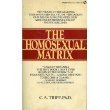The Homosexual Matrix
Select Format
Select Condition 
Book Overview
No Synopsis Available.
Format:Paperback
Language:English
ISBN:0452008476
ISBN13:9780452008472
Release Date:August 1987
Publisher:Plume Books
Length:330 Pages
Weight:1.05 lbs.
Dimensions:1.0" x 5.3" x 7.9"
Customer Reviews
1 rating
packed with juicy information and opinion on many things.
Published by Thriftbooks.com User , 16 years ago
C.A. Tripp, sharp as a tack in 1975 (less so in 2003...), wrote a book, sometimes used as a textbook in its day, full of useful and interesting information on homosexuality (sometimes, he says something which is exactly the opposite from what you thought he was going to say, but on further consideration, you decide he's probably right), and many other things as well. Who could ever forget the story of the tragically too-well matched protozoa, or his example of how the almost universal second class citizen status of women can have its rewards: No self-respecting cannibal would EVER put a woman in the stew. Most believe that woman-flesh is poison, and for those who know better, they still wouldn't do it, because, well, after all--you are what you eat! The protozoa: Protozoa are single-celled animals, who live in water. Usually, they reproduce by fission---they simply split into two protozoa. But after a while, the--whatever they're made of--gets tired, or weak, because it's simply the same animal reproducing itself. When this happens, they engage in what Tripp calls sexual reproduction (you can make up your own mind about this). The "tired" protozoa finds a nearby member of his species, and (remember, these are one-celled animals--no mouths, no sex organs, just--body fluids), dissolves a section of his body wall--as does his "mate," and they come together, exchanging some of their body fluids. This refreshes both, and they continue reproducing themselves by fission for some time. Now the scientists, studying them, realized that the ideal "mate" for the "tired" protozoa would be--a protozoa quite different from him, while the one he is likely to--exchange fluids--with is likely to be a "relative"--someone from close by in the same pond (or wherever). So: the scientists chose two protozoa from different ends of the pond, and isolated each in its own beaker. For various reasons, which I don't remember, they felt that the two they had chosen were ideal "mates" for each other. (Something close to hybridization, as it were.) Then, they put the two together in the same beaker. They immediately joined together, dissolving the part of their body walls where they would connect. And exchanged so much of their own body fluids...that both died. As I told this story to some friends, they all chuckled a little, except one girl who said "My God! They died of...love! That's not funny...." It was a great pleasure reading this book!




